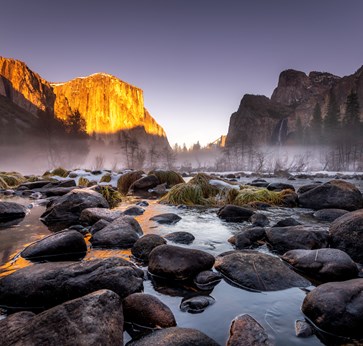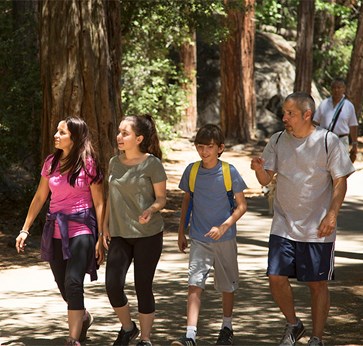Constant Change, Constant Thrill
The mountains are a place of constantly changing and unpredictable conditions—which is part of Yosemite’s allure. With elevations that range from 2,000 feet over 13,000 feet, it can feel like summer at low elevations and winter on the mountain peaks. Generally, the Sierra is known for its abundant sunshine—but rainstorms and snowstorms do happen. Below is an overview of Yosemite’s four seasons—but in any season, it’s smart to plan ahead and be prepared. Check current weather conditions here.
Winter | Spring | Summer | Fall
Winter

Because nearly three-quarters of the annual precipitation happens in the winter as snow and rain, it’s typically cold and damp from November to March. The higher you go, the earlier you’ll find snow and the longer it will take to melt—which means snowy peaks from September through April and even through May or June. It’s not uncommon for the higher elevations to receive dozens of feet of snow throughout the winter.
Spring
 In spring, Yosemite’s landscape changes dramatically as the snow begins to melt from the lower elevations to the higher elevations. In fact, sometimes trails at higher elevations aren’t accessible until July. With all the snowmelt, Yosemite’s famous waterfalls begin to show their power—with peak flow usually happening in May. Daytime temperatures can reach into the 70s Fahrenheit and dip down to below freezing after the sun sets.
In spring, Yosemite’s landscape changes dramatically as the snow begins to melt from the lower elevations to the higher elevations. In fact, sometimes trails at higher elevations aren’t accessible until July. With all the snowmelt, Yosemite’s famous waterfalls begin to show their power—with peak flow usually happening in May. Daytime temperatures can reach into the 70s Fahrenheit and dip down to below freezing after the sun sets.
Summer

At lower levels in the park, Summers are warm, dry, and sunny—with the little rainfall that does happen coming in the form of powerful but brief afternoon thunderstorms that can produce lightning and hail. During the peak of summer, days at lower elevations can reach 100 degrees Fahrenheit before dipping down into the 50s or even 40s at night. Nights in Yosemite National Park are cherished for their clear skies and incomparable stargazing.
At higher elevations, places such as White Wolf Lodge, Tuolumne Meadows, and High Sierra Camps commonly experience freezing overnight temperatures except perhaps in July. And it’s not necessarily hot during the days at these places, either.
Fall
 Warm days and cool (or even cold) nights take over as the Sierra transitions to fall. September and October tend to be filled with bright, cloudless days which make for incredible views. By fall, most of the waterfalls at Yosemite have slowed to a trickle or dried up entirely. By late fall, the snow can start falling in the park’s higher elevations—a sign that winter isn’t far behind.
Warm days and cool (or even cold) nights take over as the Sierra transitions to fall. September and October tend to be filled with bright, cloudless days which make for incredible views. By fall, most of the waterfalls at Yosemite have slowed to a trickle or dried up entirely. By late fall, the snow can start falling in the park’s higher elevations—a sign that winter isn’t far behind.
While many park visitors are content to simply sit back and enjoy the scenery, there is a variety of fall activities for park visitors to enjoy. Pleasantly brisk days provide the perfect atmosphere for bicycling, hiking, golf, rock climbing, horseback rides and sightseeing tours. Yosemite is considered one of the world's premier rock climbing destinations and a leisurely bike ride in Yosemite Valley is an fun way to view Yosemite's granite peaks and fall color. In the evenings, visitors can still enjoy outdoor programs such as Starry Skies Over Yosemite - Yosemite is famous for its dark night skies. Foodies and wine lovers are invited to join us for Vintners' Holidays winemakers dinner at The Ahwahnee, which allows you to learn about wine from some of California’s most celebrated winemakers.
Learn more about Yosemite National Park seasons, via National Park Service website:





